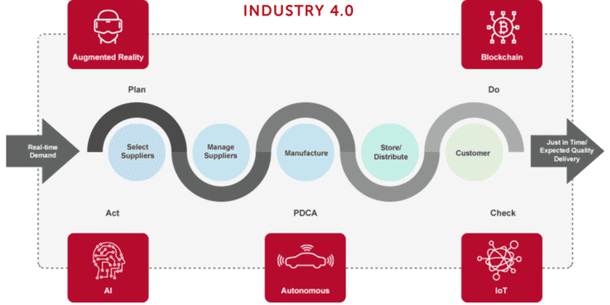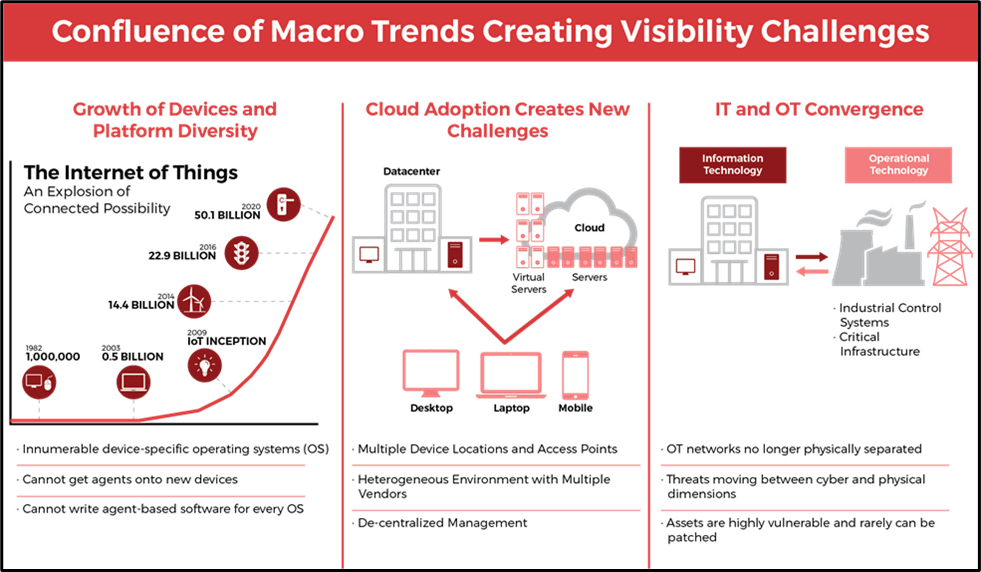What is Digital Transformation
This blog post will be Part 1 of a 4 Part series on the REAL impact of digital transformation (DX). First, the term “Digital Transformation” has been and is being used to describe almost everything related to organizations adopting digital technologies to change business models, serve their customers through new channels, integrate with suppliers and partners and almost countless other benefits. With that in mind let’s start with a clean definition of what we feel describes digital transformation. Digital transformation is the process by which companies embed technologies across their businesses to drive fundamental change. The benefits? Increased efficiency, greater business agility and, ultimately, the unlocking of new value for employees, customers, and shareholders. That definition is fairly broad, however, as we go forward, we’ll dig into the specifics of the types of technology organizations are adopting and add color to the various uses and benefits of the technology.
Digital transformation is the process by which companies embed technologies across their businesses to drive fundamental change
Digital transformation has been a buzzword for the good part of the last decade and has accelerated dramatically because of the COVID pandemic. However, the motivation to blend digital and physical processes with customer experience has never been more powerful that right now. Depending on the
industry and enterprise, the types of digital transformation may vary, but the overall goal is to drive disruptive change in your company’s go-to-market strategy.
Many different paths lead to digital transformation and each organization’s journey will likely be fairly unique. For example, a company might introduce AI or cloud computing to enhance its customer experience. Or it might redesign its supply chain to make better use of machine learning. A company can even make spot-on predictions using AI and machine learning about the products customers will want in a few months’ time, then adjust production and product teams to meet demand.
Why are Organizations Struggling to Implement a Digital Transformation Strategy?
Organizations recognize that leveraging technology is imperative to achieving their growth and profitability goals. According to the 3rd annual survey of executives by Harvard Business Review Analytic
Services—an astounding 95% of executives report an increased importance of a digital transformation strategy within their industry—the highest percentage recorded to date. However, the same survey found that 26% of the executives surveyed report that one of their biggest organizational challenges is the lack of a clearly defined digital transformation strategy.
While improved efficiency and profitability have been key drivers for all types of digital transformation, the pandemic shifted the emphasis for many executives. Business continuity and organizational resiliency have become top priorities in transforming the way organizations approach their future. The Harvard survey found that more than 75% of executives consider digital transformation significantly more critical to their organization’s success.
A successful digital transformation strategy requires organizations to define and articulate their digital goals to create broad organizational alignment. At the start, it is important to assess the organization’s digital maturity and readiness for change to then pinpoint the required critical capabilities and competencies.
Although the goal of digital transformation is to use digital technology to solve traditional problems, it’s not only about technology. Rather, the operative word is transformation. It’s about using technology to change the way your organization operates, positions itself in the marketplace and delivers benefits to customers.
| Before Digital Transformation
|
After Digital Transformation |
| We believe in research. We never interact with our customers. | Customers are at the heart of what we do. We understand them better.
|
| We don’t communicate with each other much. | We rely on brainstorming and cross-team communication to make sure everyone is on the same page.
|
| We follow research papers. | We make real-time decisions based on customer’s feedback.
|
| We know what is best. | Our customers tell us what they want.
|
If an organization’s business model relied solely on physical interaction with customers, vendors and employees, COVID-19 protocols likely severely slowed your operations. Many legacy technology companies have begun transforming their business models and cultures from “one-and-done sales” to service or subscription models that are enabled by digital technologies. With digitally native competitors unencumbered by the burden of legacy operations, there is stiff competition in the marketplace.
Digital transformation requires rethinking how an organization delivers value. It’s not just about adding technology to existing processes; it requires a radical rethinking of how an enterprise leverages technology along with operations and people to optimize performance.
During a digital transformation process, old and new revenue streams will coexist. But resources are constrained by supporting legacy operations while simultaneously implementing an everything-as-a-service (XaaS) value proposition. The image below illustrates the vision that many business leaders are implementing through their own digital transformation. Customer demand is met in real-time, leveraging the right supplies, with the right manufacturing processes and distribution all empowered with IoT, machine learning, AI, Blockchain and other disruptive technologies.

Figure 1 - Meeting Customer Demand in Real-Time by Leveraging Disruptive Digital Technologies
Simply automating or digitizing existing processes and products isn’t the only answer. Some 26% of executives identified their company’s lack of digital transformation strategy as an organizational challenge. Choosing the optimal path from among the business models is critical to accelerating transformation.
Many hardware, software and IT services markets are shrinking in the digital transformation era. Driven by the falling cost of computing power, companies are shifting to the XaaS model. For example, the supply chain industry is moving in this direction — it’s not just about owning trucks and warehouses anymore. Instead, companies are contracting for transportation and logistics as a service, outsourcing these functions to technology service experts to allow for more significant investments in their core competencies. By 2025, every enterprise will shift to a “digital innovation factory, no matter the industry.”

Figure 2 - IoT, Cloud and IT and OT Convergence will Change Business Models, Supply Chains, and Go-To-Market Strategies Dramatically
In our Cyber Hygiene 4-part blog series we introduced the image above to illustrate the security gaps that will ultimately emerge from implementing new digital investments. However, for our purposes in this post the image provides an organization a fundamental understanding of where and how the disruptive technologies will be implemented and how quickly they can expect to adopt them.
For original equipment manufacturer (OEM) technology companies, digital innovation requires rapidly transforming traditional IT into flexible XaaS models. But legacy technology OEMs undergoing this shift face both internal and external challenges. They must adopt a digital transformation mindset internally while simultaneously adapting their solution portfolio to enable their customers’ digital efforts, too. Ultimately, when done efficiently and effectively, the XaaS transformation strengthens, protects, and even brings in new revenue streams for technology OEMs.
Conclusion - There are 4 Types of Digital Transformation
Digital transformation doesn’t mean the same thing for all companies and viewing it as a one-size-fits-all process is impossible as all businesses engage customers, integrate suppliers and manufacture products differently. There are four main types of digital transformation that organizations should consider taking advantage of in their own transformation strategy. It’s critical to realize that digital transformation is not necessarily a single, templatized destination in the form of a product or offering, but instead requires a long-term commitment and can evolve throughout the digital transformation journey.
2. Business Model and Channel Transformation
Business model transformation aims to fundamentally change the way companies deliver value for customers. For example, using an story we’re all familiar with, Netflix made the transition from mailing DVDs to online streaming, while Blockbuster failed to make the transition ultimately leading to the demise of one my favorite retailers. Technology OEMs are also switching from a sales and support model to XaaS, where the “X” may be hardware, storage capacity or applications.
Technology companies can reshape their go-to-market strategy and support their customers’ digital transformation efforts with the flexibility to select technology that best suits their needs. Think about the emergence of Zoom, Peloton, Grubhub, Okta, and so many other “stay at home” companies that took massive market share during the lockdown. Customers often signal their readiness for a different type of relationship through their purchasing patterns.
1. Supply Chain and Logistical Process Transformation
Companies can revise internal processes to lower costs, improve quality and reduce cycle times. Adopting cloud connectivity helps link disparate processes and locations. For example, implementing robotic process automation can transform manual tasks found in procurement, supply chain management and other administrative functions. Modernizing your logistics network and supply chain by digitizing these processes and integrating machine learning and artificial intelligence helps to recognize and shape data patterns into actionable insights.
3. Domain and Go-to-Market Transformation
Organizations typically adopt new technologies to redefine their products and services. They might extend current services to a new customer base or develop entirely new technology-enabled offerings. For example, offering equipment on a rental basis rather than purchase-only enables you to reach a previously unserved segment of customers who may only need your technology temporarily.
As another example, companies that sell industrial equipment can expand by providing digital solutions to their existing customer base and customers using other equipment. CNH Industrial, a manufacturer of commercial, construction and agricultural equipment, developed its own suite of fleet telematics technology to help owners optimize operation and maintenance processes and connect them with the company’s dealer network for service.
4. Cultural/Organizational Transformation
Embracing a digital-first culture enables organizations to adopt agile workflows, develop a bias toward testing and learning as well as support decentralized decision-making. However, a successful transition to a digital-first culture requires redefining mindsets and processes while also incorporating new talents and capabilities.
A typical mindset shift alters from managing production output to focusing on customer service and innovation. Often, the cultural shift occurs organically during other transformation initiatives as internal teams adopt digital workflows and recognize the power of changing organizational norms.
In our next blog post on Digital Transformation we will expand our discussion from defining and describing the impact of organizations embracing IoT, AI, Machine Learning, and other technologies to digging into different examples in various industries to illustrate the benefits of their transformation as well as their cybersecurity challenges.